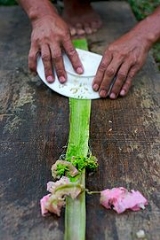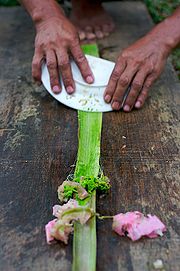
Piña
Encyclopedia
Piña is a pineapple fiber made from the leaves of a pineapple
plant and is commonly used in the Philippines
. It is sometimes combined with silk
or polyester
to create a textile
fabric. Piña's name comes from the Spanish
word piña which literally means pineapple.
 Since piña is from a leaf, the leaf has to be cut first from the plant. Then the fiber is pulled or split away from the leaf. Most leaf fibers are long and somewhat stiff. Each strand of the piña fiber is hand scraped and is knotted one by one to form a continuous filament to be handwoven and then made into a piña cloth.
Since piña is from a leaf, the leaf has to be cut first from the plant. Then the fiber is pulled or split away from the leaf. Most leaf fibers are long and somewhat stiff. Each strand of the piña fiber is hand scraped and is knotted one by one to form a continuous filament to be handwoven and then made into a piña cloth.
is the main and the oldest manufacturer/weaver of piña cloth in the Philippines
which are being exported to various parts of the world most particularly North America, and Europe. Piña weaving is an age-old tradition which was recently revived in the past 20 years. History records suggest that Kalibo's piña cloth was traded during the Pre-Hispanic times and reached as far as Greece and Egypt during its heyday, although the pineapple plant was brought to the Philippines by the Spaniards from the Americas. Kalibo is also known for other native products such as handbags made of buri leaves which is a favorite for Caucasian females visiting the town. Pineapple silk is considered the queen of Philippine fabrics and is considered the fabric of choice of the Philippine elite. During the 1996 edition of APEC in the Philippines, world leaders donned a pineapple silk Barong Tagalog
from Kalibo during the traditional group photo.
- De La Cruz House of Piña
- Malabon Pina Producers and Weavers Association http://www1.winner-tips.org/article/view/212
- Reycon's Piña Cloth and Industry http://www.expertrade.com.ph/pages/REYCON'S%20PINA%20CLOTH%20&%20INDUSTRY.html
- Rurungan sa Tubod Foundation http://rurungan.org
Piña is a Spanish last name with the Portuguese equivalent being Pina.
and other formal wear that is common in the Philippines
. It is also used for other table linens, bags, mats and other clothing items, or anytime that a lightweight, but stiff and sheer fabric is needed.
Pineapple
Pineapple is the common name for a tropical plant and its edible fruit, which is actually a multiple fruit consisting of coalesced berries. It was given the name pineapple due to its resemblance to a pine cone. The pineapple is by far the most economically important plant in the Bromeliaceae...
plant and is commonly used in the Philippines
Philippines
The Philippines , officially known as the Republic of the Philippines , is a country in Southeast Asia in the western Pacific Ocean. To its north across the Luzon Strait lies Taiwan. West across the South China Sea sits Vietnam...
. It is sometimes combined with silk
Silk
Silk is a natural protein fiber, some forms of which can be woven into textiles. The best-known type of silk is obtained from the cocoons of the larvae of the mulberry silkworm Bombyx mori reared in captivity...
or polyester
Polyester
Polyester is a category of polymers which contain the ester functional group in their main chain. Although there are many polyesters, the term "polyester" as a specific material most commonly refers to polyethylene terephthalate...
to create a textile
Textile
A textile or cloth is a flexible woven material consisting of a network of natural or artificial fibres often referred to as thread or yarn. Yarn is produced by spinning raw fibres of wool, flax, cotton, or other material to produce long strands...
fabric. Piña's name comes from the Spanish
Spanish language
Spanish , also known as Castilian , is a Romance language in the Ibero-Romance group that evolved from several languages and dialects in central-northern Iberia around the 9th century and gradually spread with the expansion of the Kingdom of Castile into central and southern Iberia during the...
word piña which literally means pineapple.
Production methods

Producers
Kalibo, AklanAklan
Aklan is a province of the Philippines located in the Western Visayas. Its capital is Kalibo. It is located at the northwest portion of Panay Island, bordering Antique Province to the southwest, and Capiz Province to the east...
is the main and the oldest manufacturer/weaver of piña cloth in the Philippines
Philippines
The Philippines , officially known as the Republic of the Philippines , is a country in Southeast Asia in the western Pacific Ocean. To its north across the Luzon Strait lies Taiwan. West across the South China Sea sits Vietnam...
which are being exported to various parts of the world most particularly North America, and Europe. Piña weaving is an age-old tradition which was recently revived in the past 20 years. History records suggest that Kalibo's piña cloth was traded during the Pre-Hispanic times and reached as far as Greece and Egypt during its heyday, although the pineapple plant was brought to the Philippines by the Spaniards from the Americas. Kalibo is also known for other native products such as handbags made of buri leaves which is a favorite for Caucasian females visiting the town. Pineapple silk is considered the queen of Philippine fabrics and is considered the fabric of choice of the Philippine elite. During the 1996 edition of APEC in the Philippines, world leaders donned a pineapple silk Barong Tagalog
Barong Tagalog
The barong Tagalog is an embroidered formal garment of the Philippines. It is very lightweight and worn untucked , over an undershirt. In Filipino culture it is a common wedding and formal attire, mostly for men but also for women...
from Kalibo during the traditional group photo.
- De La Cruz House of Piña
- Malabon Pina Producers and Weavers Association http://www1.winner-tips.org/article/view/212
- Reycon's Piña Cloth and Industry http://www.expertrade.com.ph/pages/REYCON'S%20PINA%20CLOTH%20&%20INDUSTRY.html
- Rurungan sa Tubod Foundation http://rurungan.org
Trade names
None found at this time. Piña is often referred to as pineapple fiber.Piña is a Spanish last name with the Portuguese equivalent being Pina.
Uses
A major use for piña fabric is in the creation of the Barong TagalogBarong Tagalog
The barong Tagalog is an embroidered formal garment of the Philippines. It is very lightweight and worn untucked , over an undershirt. In Filipino culture it is a common wedding and formal attire, mostly for men but also for women...
and other formal wear that is common in the Philippines
Philippines
The Philippines , officially known as the Republic of the Philippines , is a country in Southeast Asia in the western Pacific Ocean. To its north across the Luzon Strait lies Taiwan. West across the South China Sea sits Vietnam...
. It is also used for other table linens, bags, mats and other clothing items, or anytime that a lightweight, but stiff and sheer fabric is needed.

